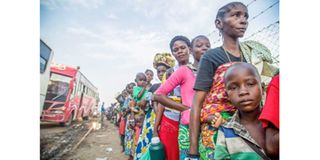UNHCR: Climate change, Covid crisis tripling plight of refugee women

Congolese refugees wait in line to board a bus towards a refugee settlement in Sebagoro, Uganda, on February 16, 2018. The UNHCR has raised the red flag over increasing suffering of female refugees across the world.
What you need to know:
- UNCR official says that in some contexts where families are hit by conflict, disaster, insecurity and spiralling poverty, girls are taken out of school to work, beg, be married off, and, in the most extreme cases, to be sold.
- She noted gender inequality as both a root cause and a consequence of forced displacement, expressing fear it will only deepen climate change effects and enhance inequities in access to natural resources, among other necessities.
The United Nations High Commissioner for Refugees (UNHCR) has raised the red flag over increasing suffering of female refugees across the world.
The UNHCR has disclosed that new and existing conflicts, climate change and the Covid-19 crisis are delivering a triple blow to the rights and safety of refugee, internally displaced and stateless women and girls.
UNHCR Assistant High Commissioner for Protection Gillian Triggs, in a statement, said the last two years into the pandemic have seen increased reports of gender-based violence (GBV)—from domestic violence, forced marriages, child labour, to trafficking and exploitation.
Ms Triggs noted that in some contexts where families are hit by conflict, disaster, insecurity and spiralling poverty, girls are taken out of school to work, beg, be married off, and, in the most extreme cases, to be sold.
“Worsening socio-economic conditions, aggravated by the pandemic, mean displaced women and girls are among those hardest hit,” said Ms Triggs.
Gender inequalities
She noted gender inequality as both a root cause and a consequence of forced displacement, expressing fear that it will only deepen the impacts of climate change and enhance inequities in access to natural resources, legal rights, livelihood opportunities, formalised safety nets, technologies and information, among other necessities.
“We know from our daily interactions that women and girls living in humanitarian crises and armed conflicts are at heightened risk,” she said.
She urged governments, civil society and communities to address gender inequality in all its forms and to support and promote the leadership, inclusion, and full participation of displaced women and girls.
The UN body said unless concerted efforts are made to work in partnership with forcibly displaced women and girls to transform systems and harmful social norms that perpetuate gender inequality and discrimination, the world risk leaving behind refugee and forcibly displaced women and girls.
The agency is committed to supporting local, women-led, frontline responses and strengthen collaboration with women-led organisations, especially those led by refugee, stateless and internally displaced women.
According to the UN Women, Half of the world’s refugees are women and girls. The agency also approximates that 71 million people or one out of every 108 people are forcibly displaced.
Most of them (over 80 per cent) live in countries with weak and under-resourced healthcare infrastructure where systems are unlikely to handle the scale of this crisis. They face added risks of having limited access to water, sanitation systems and health facilities.
Research carried out by Plan International in previous humanitarian crises revealed the devastating impacts emergencies have on girls, both immediately and in the longer term.
Burden
According to the analysis of previous crises, including the Ebola epidemic, girls and women are at risk of failing to return to school, failing to find employment when economies reopen and suffering abuse and violence at home.
They also suffer economic hardship, lack of food, an increase in child marriage and unwanted pregnancy and greater exposure to Covid-19 due to traditional roles as primary caregivers.
Kenya continues to be among the top refugee-hosting countries in Africa and currently has more than 500,000 refugees.
The UN agency indicates that the majority of refugees and asylum seekers in Kenya originate from Somalia (54 per cent). South Sudanese account for 24.6 percent, Congolese nine per cent, and Ethiopians 5.8 per cent.
Refugees from Sudan, Rwanda, Eritrea, Burundi, Uganda among others make up 6.8 per cent of the total population.
UNHCR indicates almost half of the refugees in Kenya (44 per cent) reside in Dadaab, 40 per cent in Kakuma and 16 per cent in urban areas (mainly Nairobi), alongside 18,500 stateless persons.





